People Management in Healthcare: NHS Case Study and Analysis Report
VerifiedAdded on 2023/01/18
|11
|2596
|32
Report
AI Summary
This report provides an in-depth analysis of people management within the National Health Service (NHS), focusing on leadership, training and development, and talent management. The report begins with an introduction to people management principles and then applies key theoretical models, such as contingency theory and expectancy theory, to the NHS context. It examines the roles and priorities of NHS management, including recruitment, training, and legal responsibilities. The report then delves into internal and external influences on leadership, management, training, and talent management, highlighting factors like employee relations, social factors, organizational resources, and healthcare regulations. Finally, the report offers strategic recommendations for the NHS to address staff shortages, improve employee retention, and optimize its people management practices, emphasizing the adoption of contingency leadership and continuous training programs.
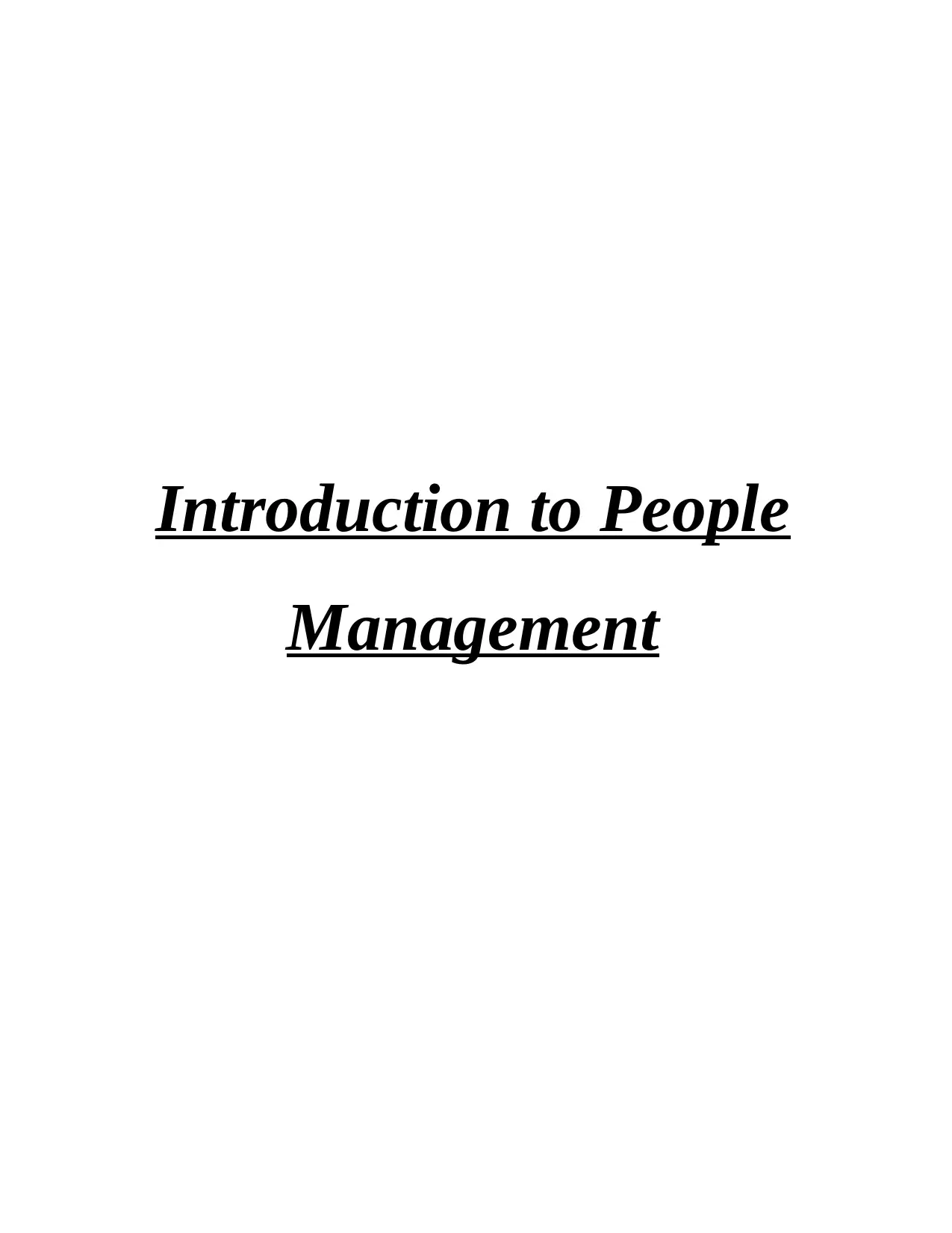
Introduction to People
Management
Management
Secure Best Marks with AI Grader
Need help grading? Try our AI Grader for instant feedback on your assignments.
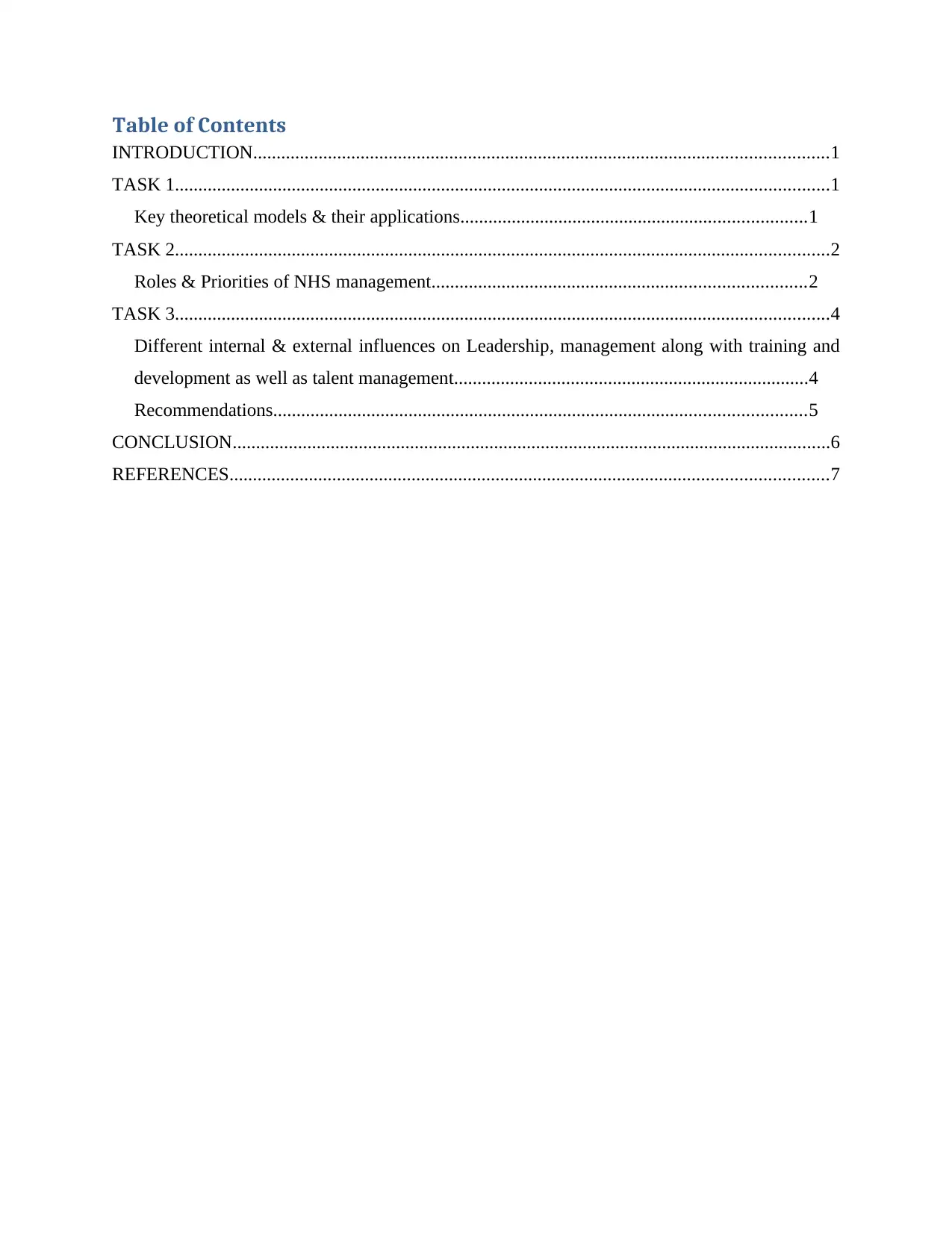
Table of Contents
INTRODUCTION...........................................................................................................................1
TASK 1............................................................................................................................................1
Key theoretical models & their applications..........................................................................1
TASK 2............................................................................................................................................2
Roles & Priorities of NHS management................................................................................2
TASK 3............................................................................................................................................4
Different internal & external influences on Leadership, management along with training and
development as well as talent management............................................................................4
Recommendations..................................................................................................................5
CONCLUSION................................................................................................................................6
REFERENCES................................................................................................................................7
INTRODUCTION...........................................................................................................................1
TASK 1............................................................................................................................................1
Key theoretical models & their applications..........................................................................1
TASK 2............................................................................................................................................2
Roles & Priorities of NHS management................................................................................2
TASK 3............................................................................................................................................4
Different internal & external influences on Leadership, management along with training and
development as well as talent management............................................................................4
Recommendations..................................................................................................................5
CONCLUSION................................................................................................................................6
REFERENCES................................................................................................................................7
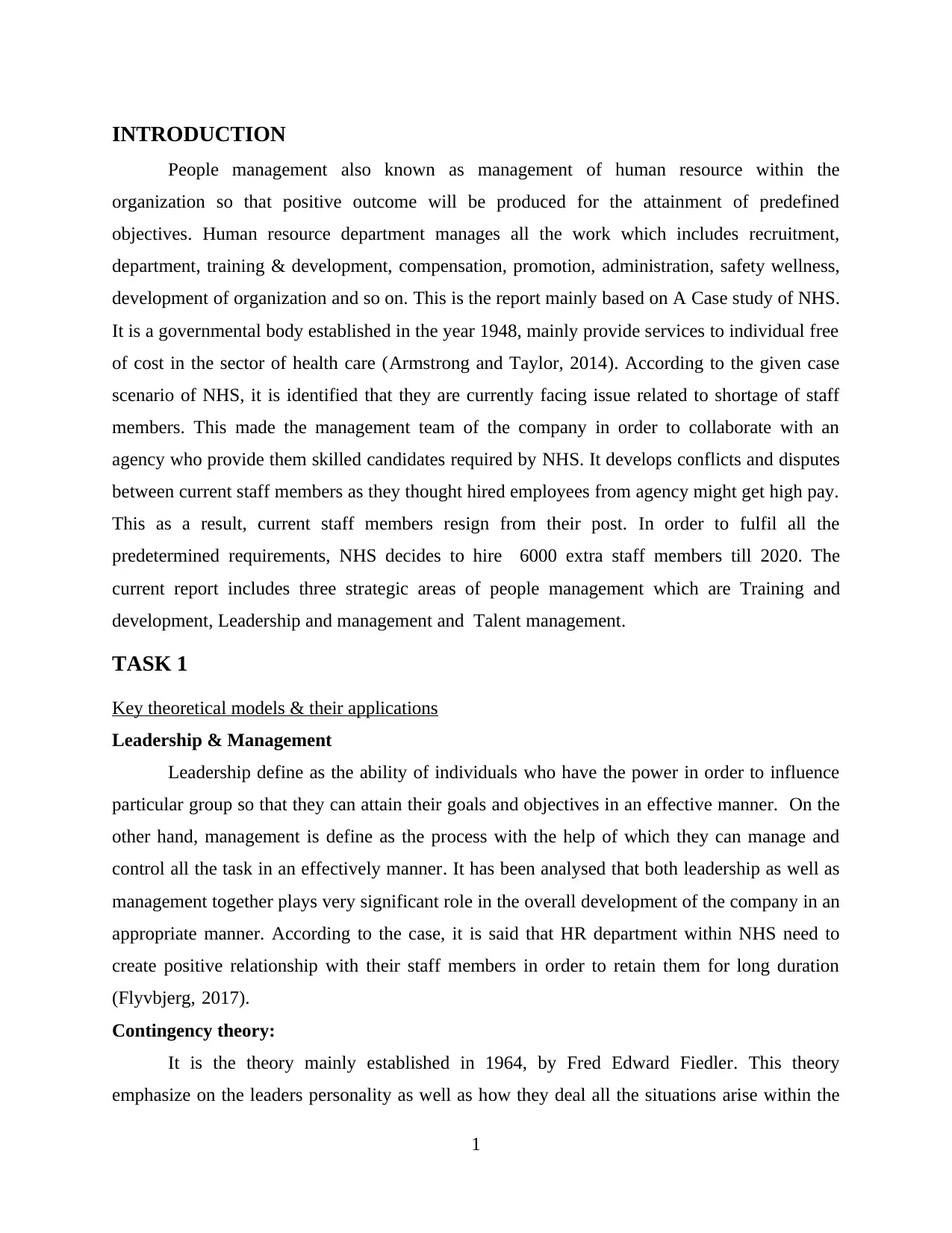
INTRODUCTION
People management also known as management of human resource within the
organization so that positive outcome will be produced for the attainment of predefined
objectives. Human resource department manages all the work which includes recruitment,
department, training & development, compensation, promotion, administration, safety wellness,
development of organization and so on. This is the report mainly based on A Case study of NHS.
It is a governmental body established in the year 1948, mainly provide services to individual free
of cost in the sector of health care (Armstrong and Taylor, 2014). According to the given case
scenario of NHS, it is identified that they are currently facing issue related to shortage of staff
members. This made the management team of the company in order to collaborate with an
agency who provide them skilled candidates required by NHS. It develops conflicts and disputes
between current staff members as they thought hired employees from agency might get high pay.
This as a result, current staff members resign from their post. In order to fulfil all the
predetermined requirements, NHS decides to hire 6000 extra staff members till 2020. The
current report includes three strategic areas of people management which are Training and
development, Leadership and management and Talent management.
TASK 1
Key theoretical models & their applications
Leadership & Management
Leadership define as the ability of individuals who have the power in order to influence
particular group so that they can attain their goals and objectives in an effective manner. On the
other hand, management is define as the process with the help of which they can manage and
control all the task in an effectively manner. It has been analysed that both leadership as well as
management together plays very significant role in the overall development of the company in an
appropriate manner. According to the case, it is said that HR department within NHS need to
create positive relationship with their staff members in order to retain them for long duration
(Flyvbjerg, 2017).
Contingency theory:
It is the theory mainly established in 1964, by Fred Edward Fiedler. This theory
emphasize on the leaders personality as well as how they deal all the situations arise within the
1
People management also known as management of human resource within the
organization so that positive outcome will be produced for the attainment of predefined
objectives. Human resource department manages all the work which includes recruitment,
department, training & development, compensation, promotion, administration, safety wellness,
development of organization and so on. This is the report mainly based on A Case study of NHS.
It is a governmental body established in the year 1948, mainly provide services to individual free
of cost in the sector of health care (Armstrong and Taylor, 2014). According to the given case
scenario of NHS, it is identified that they are currently facing issue related to shortage of staff
members. This made the management team of the company in order to collaborate with an
agency who provide them skilled candidates required by NHS. It develops conflicts and disputes
between current staff members as they thought hired employees from agency might get high pay.
This as a result, current staff members resign from their post. In order to fulfil all the
predetermined requirements, NHS decides to hire 6000 extra staff members till 2020. The
current report includes three strategic areas of people management which are Training and
development, Leadership and management and Talent management.
TASK 1
Key theoretical models & their applications
Leadership & Management
Leadership define as the ability of individuals who have the power in order to influence
particular group so that they can attain their goals and objectives in an effective manner. On the
other hand, management is define as the process with the help of which they can manage and
control all the task in an effectively manner. It has been analysed that both leadership as well as
management together plays very significant role in the overall development of the company in an
appropriate manner. According to the case, it is said that HR department within NHS need to
create positive relationship with their staff members in order to retain them for long duration
(Flyvbjerg, 2017).
Contingency theory:
It is the theory mainly established in 1964, by Fred Edward Fiedler. This theory
emphasize on the leaders personality as well as how they deal all the situations arise within the
1
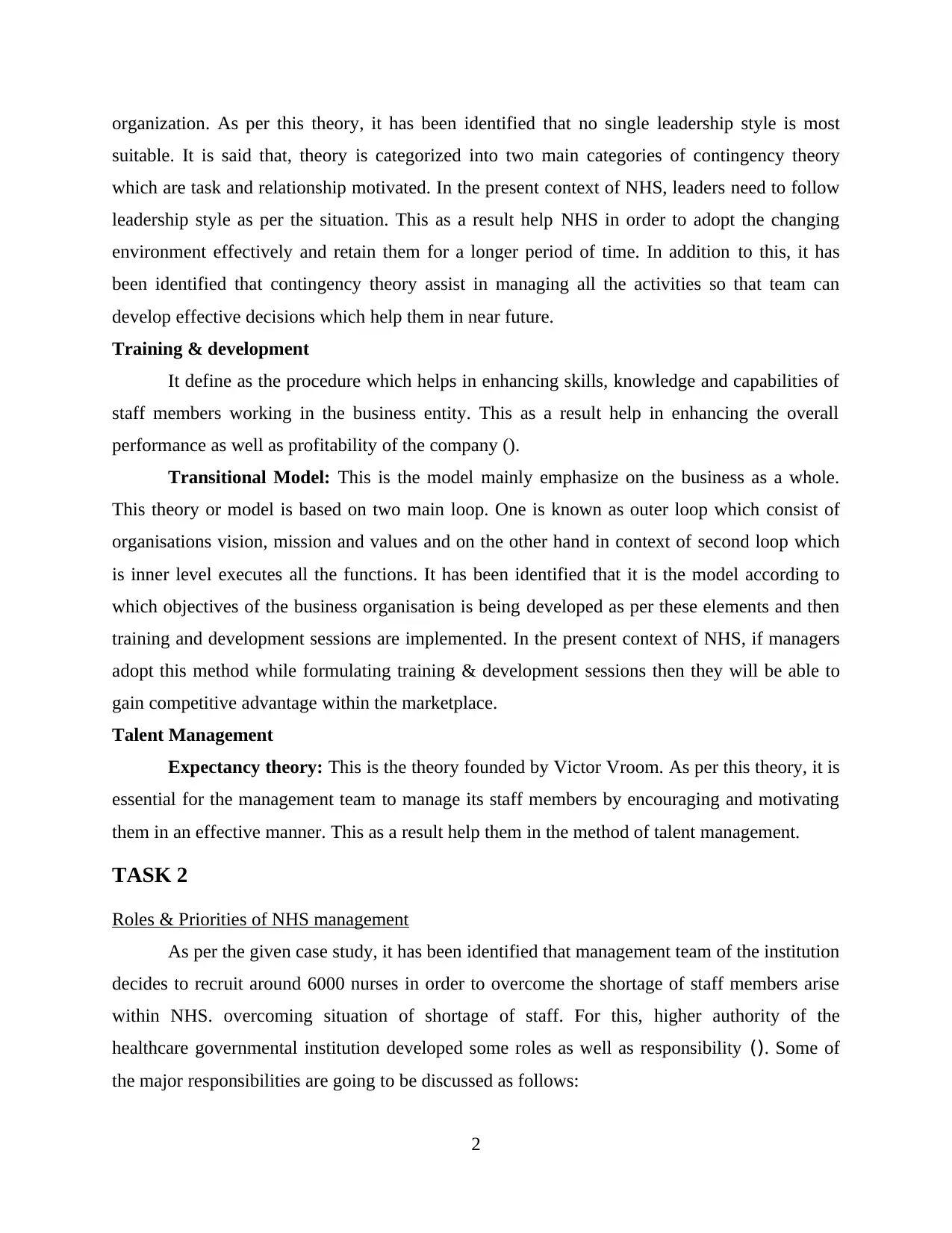
organization. As per this theory, it has been identified that no single leadership style is most
suitable. It is said that, theory is categorized into two main categories of contingency theory
which are task and relationship motivated. In the present context of NHS, leaders need to follow
leadership style as per the situation. This as a result help NHS in order to adopt the changing
environment effectively and retain them for a longer period of time. In addition to this, it has
been identified that contingency theory assist in managing all the activities so that team can
develop effective decisions which help them in near future.
Training & development
It define as the procedure which helps in enhancing skills, knowledge and capabilities of
staff members working in the business entity. This as a result help in enhancing the overall
performance as well as profitability of the company ().
Transitional Model: This is the model mainly emphasize on the business as a whole.
This theory or model is based on two main loop. One is known as outer loop which consist of
organisations vision, mission and values and on the other hand in context of second loop which
is inner level executes all the functions. It has been identified that it is the model according to
which objectives of the business organisation is being developed as per these elements and then
training and development sessions are implemented. In the present context of NHS, if managers
adopt this method while formulating training & development sessions then they will be able to
gain competitive advantage within the marketplace.
Talent Management
Expectancy theory: This is the theory founded by Victor Vroom. As per this theory, it is
essential for the management team to manage its staff members by encouraging and motivating
them in an effective manner. This as a result help them in the method of talent management.
TASK 2
Roles & Priorities of NHS management
As per the given case study, it has been identified that management team of the institution
decides to recruit around 6000 nurses in order to overcome the shortage of staff members arise
within NHS. overcoming situation of shortage of staff. For this, higher authority of the
healthcare governmental institution developed some roles as well as responsibility (). Some of
the major responsibilities are going to be discussed as follows:
2
suitable. It is said that, theory is categorized into two main categories of contingency theory
which are task and relationship motivated. In the present context of NHS, leaders need to follow
leadership style as per the situation. This as a result help NHS in order to adopt the changing
environment effectively and retain them for a longer period of time. In addition to this, it has
been identified that contingency theory assist in managing all the activities so that team can
develop effective decisions which help them in near future.
Training & development
It define as the procedure which helps in enhancing skills, knowledge and capabilities of
staff members working in the business entity. This as a result help in enhancing the overall
performance as well as profitability of the company ().
Transitional Model: This is the model mainly emphasize on the business as a whole.
This theory or model is based on two main loop. One is known as outer loop which consist of
organisations vision, mission and values and on the other hand in context of second loop which
is inner level executes all the functions. It has been identified that it is the model according to
which objectives of the business organisation is being developed as per these elements and then
training and development sessions are implemented. In the present context of NHS, if managers
adopt this method while formulating training & development sessions then they will be able to
gain competitive advantage within the marketplace.
Talent Management
Expectancy theory: This is the theory founded by Victor Vroom. As per this theory, it is
essential for the management team to manage its staff members by encouraging and motivating
them in an effective manner. This as a result help them in the method of talent management.
TASK 2
Roles & Priorities of NHS management
As per the given case study, it has been identified that management team of the institution
decides to recruit around 6000 nurses in order to overcome the shortage of staff members arise
within NHS. overcoming situation of shortage of staff. For this, higher authority of the
healthcare governmental institution developed some roles as well as responsibility (). Some of
the major responsibilities are going to be discussed as follows:
2
Secure Best Marks with AI Grader
Need help grading? Try our AI Grader for instant feedback on your assignments.
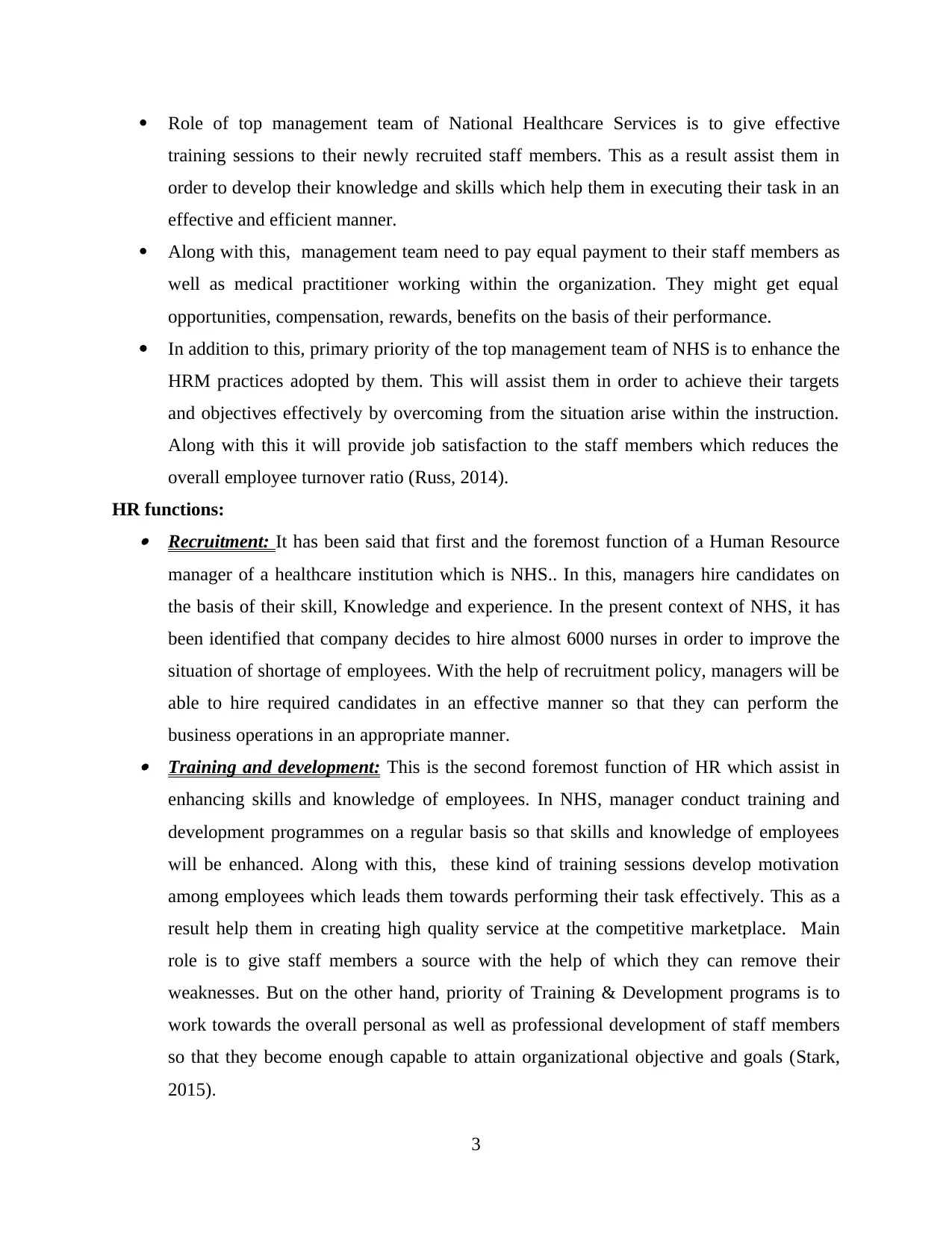
Role of top management team of National Healthcare Services is to give effective
training sessions to their newly recruited staff members. This as a result assist them in
order to develop their knowledge and skills which help them in executing their task in an
effective and efficient manner.
Along with this, management team need to pay equal payment to their staff members as
well as medical practitioner working within the organization. They might get equal
opportunities, compensation, rewards, benefits on the basis of their performance.
In addition to this, primary priority of the top management team of NHS is to enhance the
HRM practices adopted by them. This will assist them in order to achieve their targets
and objectives effectively by overcoming from the situation arise within the instruction.
Along with this it will provide job satisfaction to the staff members which reduces the
overall employee turnover ratio (Russ, 2014).
HR functions: Recruitment: It has been said that first and the foremost function of a Human Resource
manager of a healthcare institution which is NHS.. In this, managers hire candidates on
the basis of their skill, Knowledge and experience. In the present context of NHS, it has
been identified that company decides to hire almost 6000 nurses in order to improve the
situation of shortage of employees. With the help of recruitment policy, managers will be
able to hire required candidates in an effective manner so that they can perform the
business operations in an appropriate manner. Training and development: This is the second foremost function of HR which assist in
enhancing skills and knowledge of employees. In NHS, manager conduct training and
development programmes on a regular basis so that skills and knowledge of employees
will be enhanced. Along with this, these kind of training sessions develop motivation
among employees which leads them towards performing their task effectively. This as a
result help them in creating high quality service at the competitive marketplace. Main
role is to give staff members a source with the help of which they can remove their
weaknesses. But on the other hand, priority of Training & Development programs is to
work towards the overall personal as well as professional development of staff members
so that they become enough capable to attain organizational objective and goals (Stark,
2015).
3
training sessions to their newly recruited staff members. This as a result assist them in
order to develop their knowledge and skills which help them in executing their task in an
effective and efficient manner.
Along with this, management team need to pay equal payment to their staff members as
well as medical practitioner working within the organization. They might get equal
opportunities, compensation, rewards, benefits on the basis of their performance.
In addition to this, primary priority of the top management team of NHS is to enhance the
HRM practices adopted by them. This will assist them in order to achieve their targets
and objectives effectively by overcoming from the situation arise within the instruction.
Along with this it will provide job satisfaction to the staff members which reduces the
overall employee turnover ratio (Russ, 2014).
HR functions: Recruitment: It has been said that first and the foremost function of a Human Resource
manager of a healthcare institution which is NHS.. In this, managers hire candidates on
the basis of their skill, Knowledge and experience. In the present context of NHS, it has
been identified that company decides to hire almost 6000 nurses in order to improve the
situation of shortage of employees. With the help of recruitment policy, managers will be
able to hire required candidates in an effective manner so that they can perform the
business operations in an appropriate manner. Training and development: This is the second foremost function of HR which assist in
enhancing skills and knowledge of employees. In NHS, manager conduct training and
development programmes on a regular basis so that skills and knowledge of employees
will be enhanced. Along with this, these kind of training sessions develop motivation
among employees which leads them towards performing their task effectively. This as a
result help them in creating high quality service at the competitive marketplace. Main
role is to give staff members a source with the help of which they can remove their
weaknesses. But on the other hand, priority of Training & Development programs is to
work towards the overall personal as well as professional development of staff members
so that they become enough capable to attain organizational objective and goals (Stark,
2015).
3
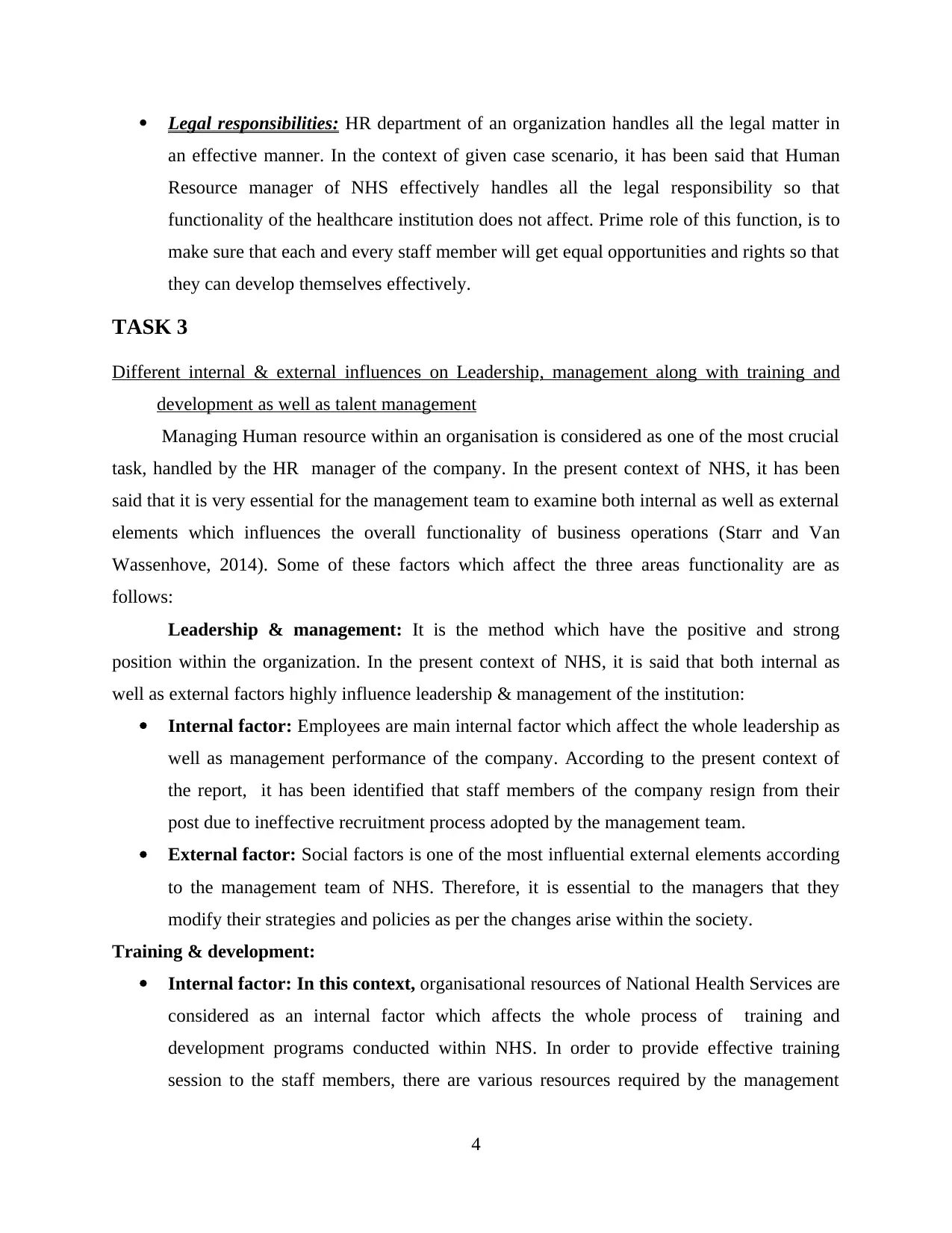
Legal responsibilities: HR department of an organization handles all the legal matter in
an effective manner. In the context of given case scenario, it has been said that Human
Resource manager of NHS effectively handles all the legal responsibility so that
functionality of the healthcare institution does not affect. Prime role of this function, is to
make sure that each and every staff member will get equal opportunities and rights so that
they can develop themselves effectively.
TASK 3
Different internal & external influences on Leadership, management along with training and
development as well as talent management
Managing Human resource within an organisation is considered as one of the most crucial
task, handled by the HR manager of the company. In the present context of NHS, it has been
said that it is very essential for the management team to examine both internal as well as external
elements which influences the overall functionality of business operations (Starr and Van
Wassenhove, 2014). Some of these factors which affect the three areas functionality are as
follows:
Leadership & management: It is the method which have the positive and strong
position within the organization. In the present context of NHS, it is said that both internal as
well as external factors highly influence leadership & management of the institution:
Internal factor: Employees are main internal factor which affect the whole leadership as
well as management performance of the company. According to the present context of
the report, it has been identified that staff members of the company resign from their
post due to ineffective recruitment process adopted by the management team.
External factor: Social factors is one of the most influential external elements according
to the management team of NHS. Therefore, it is essential to the managers that they
modify their strategies and policies as per the changes arise within the society.
Training & development:
Internal factor: In this context, organisational resources of National Health Services are
considered as an internal factor which affects the whole process of training and
development programs conducted within NHS. In order to provide effective training
session to the staff members, there are various resources required by the management
4
an effective manner. In the context of given case scenario, it has been said that Human
Resource manager of NHS effectively handles all the legal responsibility so that
functionality of the healthcare institution does not affect. Prime role of this function, is to
make sure that each and every staff member will get equal opportunities and rights so that
they can develop themselves effectively.
TASK 3
Different internal & external influences on Leadership, management along with training and
development as well as talent management
Managing Human resource within an organisation is considered as one of the most crucial
task, handled by the HR manager of the company. In the present context of NHS, it has been
said that it is very essential for the management team to examine both internal as well as external
elements which influences the overall functionality of business operations (Starr and Van
Wassenhove, 2014). Some of these factors which affect the three areas functionality are as
follows:
Leadership & management: It is the method which have the positive and strong
position within the organization. In the present context of NHS, it is said that both internal as
well as external factors highly influence leadership & management of the institution:
Internal factor: Employees are main internal factor which affect the whole leadership as
well as management performance of the company. According to the present context of
the report, it has been identified that staff members of the company resign from their
post due to ineffective recruitment process adopted by the management team.
External factor: Social factors is one of the most influential external elements according
to the management team of NHS. Therefore, it is essential to the managers that they
modify their strategies and policies as per the changes arise within the society.
Training & development:
Internal factor: In this context, organisational resources of National Health Services are
considered as an internal factor which affects the whole process of training and
development programs conducted within NHS. In order to provide effective training
session to the staff members, there are various resources required by the management
4
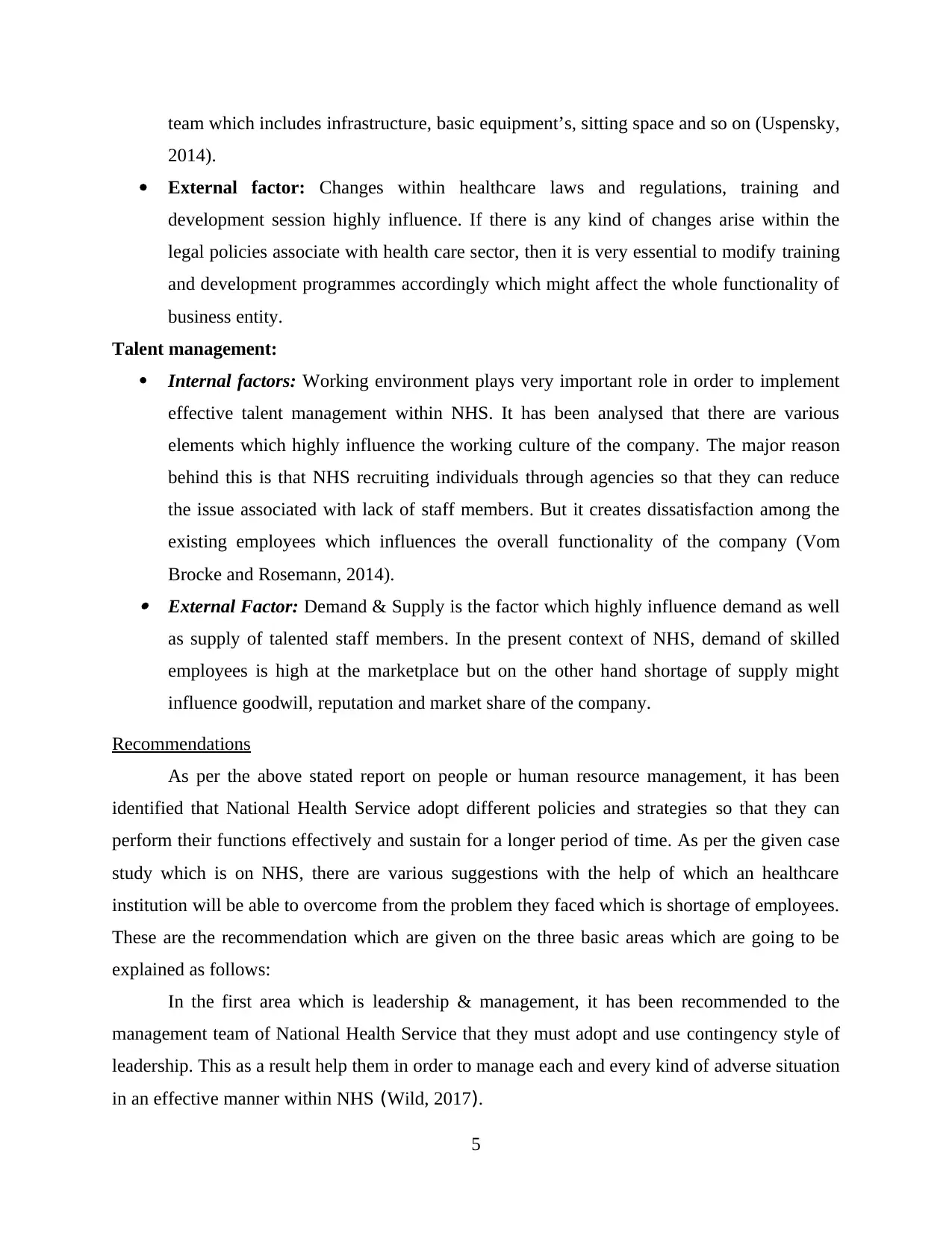
team which includes infrastructure, basic equipment’s, sitting space and so on (Uspensky,
2014).
External factor: Changes within healthcare laws and regulations, training and
development session highly influence. If there is any kind of changes arise within the
legal policies associate with health care sector, then it is very essential to modify training
and development programmes accordingly which might affect the whole functionality of
business entity.
Talent management:
Internal factors: Working environment plays very important role in order to implement
effective talent management within NHS. It has been analysed that there are various
elements which highly influence the working culture of the company. The major reason
behind this is that NHS recruiting individuals through agencies so that they can reduce
the issue associated with lack of staff members. But it creates dissatisfaction among the
existing employees which influences the overall functionality of the company (Vom
Brocke and Rosemann, 2014). External Factor: Demand & Supply is the factor which highly influence demand as well
as supply of talented staff members. In the present context of NHS, demand of skilled
employees is high at the marketplace but on the other hand shortage of supply might
influence goodwill, reputation and market share of the company.
Recommendations
As per the above stated report on people or human resource management, it has been
identified that National Health Service adopt different policies and strategies so that they can
perform their functions effectively and sustain for a longer period of time. As per the given case
study which is on NHS, there are various suggestions with the help of which an healthcare
institution will be able to overcome from the problem they faced which is shortage of employees.
These are the recommendation which are given on the three basic areas which are going to be
explained as follows:
In the first area which is leadership & management, it has been recommended to the
management team of National Health Service that they must adopt and use contingency style of
leadership. This as a result help them in order to manage each and every kind of adverse situation
in an effective manner within NHS (Wild, 2017).
5
2014).
External factor: Changes within healthcare laws and regulations, training and
development session highly influence. If there is any kind of changes arise within the
legal policies associate with health care sector, then it is very essential to modify training
and development programmes accordingly which might affect the whole functionality of
business entity.
Talent management:
Internal factors: Working environment plays very important role in order to implement
effective talent management within NHS. It has been analysed that there are various
elements which highly influence the working culture of the company. The major reason
behind this is that NHS recruiting individuals through agencies so that they can reduce
the issue associated with lack of staff members. But it creates dissatisfaction among the
existing employees which influences the overall functionality of the company (Vom
Brocke and Rosemann, 2014). External Factor: Demand & Supply is the factor which highly influence demand as well
as supply of talented staff members. In the present context of NHS, demand of skilled
employees is high at the marketplace but on the other hand shortage of supply might
influence goodwill, reputation and market share of the company.
Recommendations
As per the above stated report on people or human resource management, it has been
identified that National Health Service adopt different policies and strategies so that they can
perform their functions effectively and sustain for a longer period of time. As per the given case
study which is on NHS, there are various suggestions with the help of which an healthcare
institution will be able to overcome from the problem they faced which is shortage of employees.
These are the recommendation which are given on the three basic areas which are going to be
explained as follows:
In the first area which is leadership & management, it has been recommended to the
management team of National Health Service that they must adopt and use contingency style of
leadership. This as a result help them in order to manage each and every kind of adverse situation
in an effective manner within NHS (Wild, 2017).
5
Paraphrase This Document
Need a fresh take? Get an instant paraphrase of this document with our AI Paraphraser
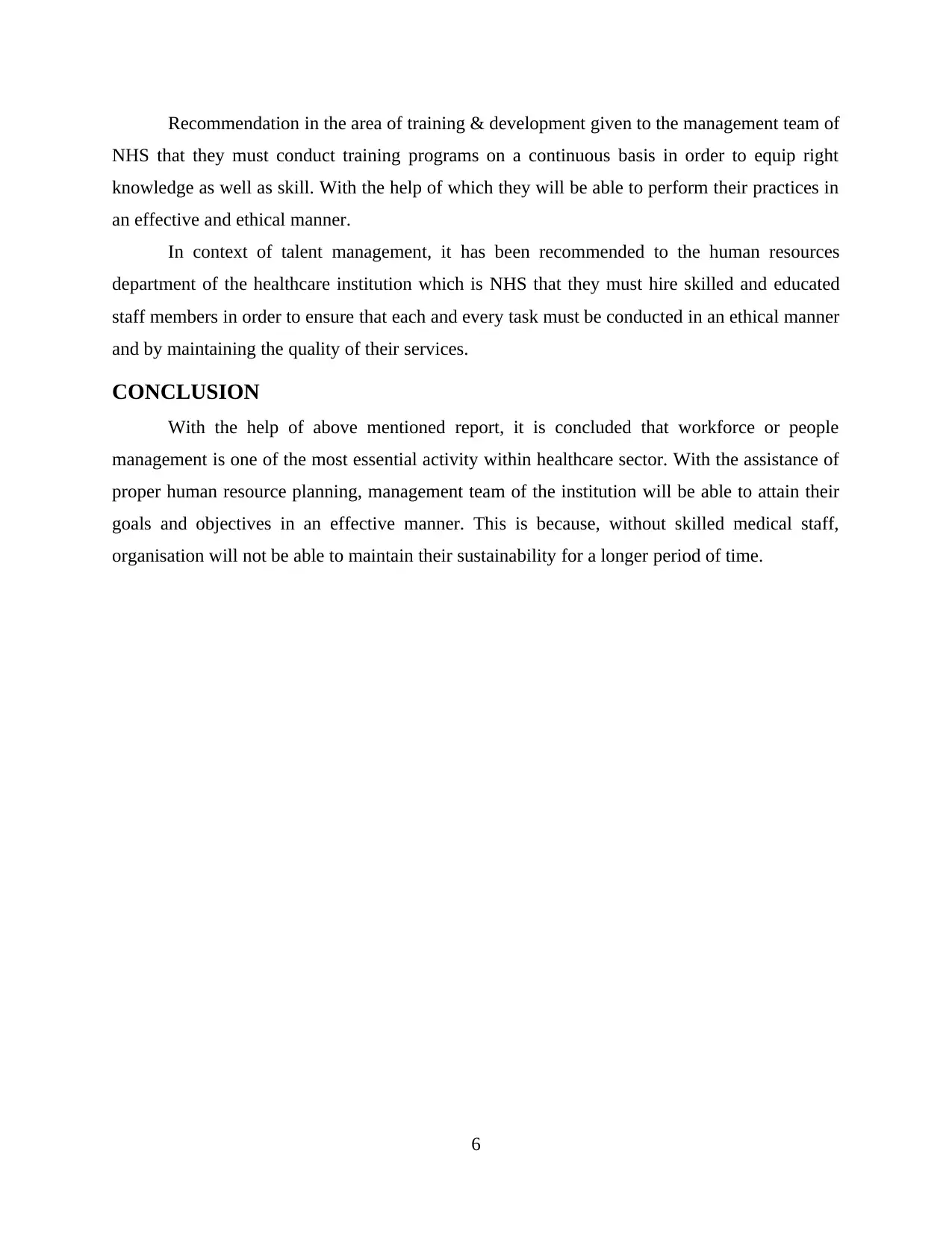
Recommendation in the area of training & development given to the management team of
NHS that they must conduct training programs on a continuous basis in order to equip right
knowledge as well as skill. With the help of which they will be able to perform their practices in
an effective and ethical manner.
In context of talent management, it has been recommended to the human resources
department of the healthcare institution which is NHS that they must hire skilled and educated
staff members in order to ensure that each and every task must be conducted in an ethical manner
and by maintaining the quality of their services.
CONCLUSION
With the help of above mentioned report, it is concluded that workforce or people
management is one of the most essential activity within healthcare sector. With the assistance of
proper human resource planning, management team of the institution will be able to attain their
goals and objectives in an effective manner. This is because, without skilled medical staff,
organisation will not be able to maintain their sustainability for a longer period of time.
6
NHS that they must conduct training programs on a continuous basis in order to equip right
knowledge as well as skill. With the help of which they will be able to perform their practices in
an effective and ethical manner.
In context of talent management, it has been recommended to the human resources
department of the healthcare institution which is NHS that they must hire skilled and educated
staff members in order to ensure that each and every task must be conducted in an ethical manner
and by maintaining the quality of their services.
CONCLUSION
With the help of above mentioned report, it is concluded that workforce or people
management is one of the most essential activity within healthcare sector. With the assistance of
proper human resource planning, management team of the institution will be able to attain their
goals and objectives in an effective manner. This is because, without skilled medical staff,
organisation will not be able to maintain their sustainability for a longer period of time.
6
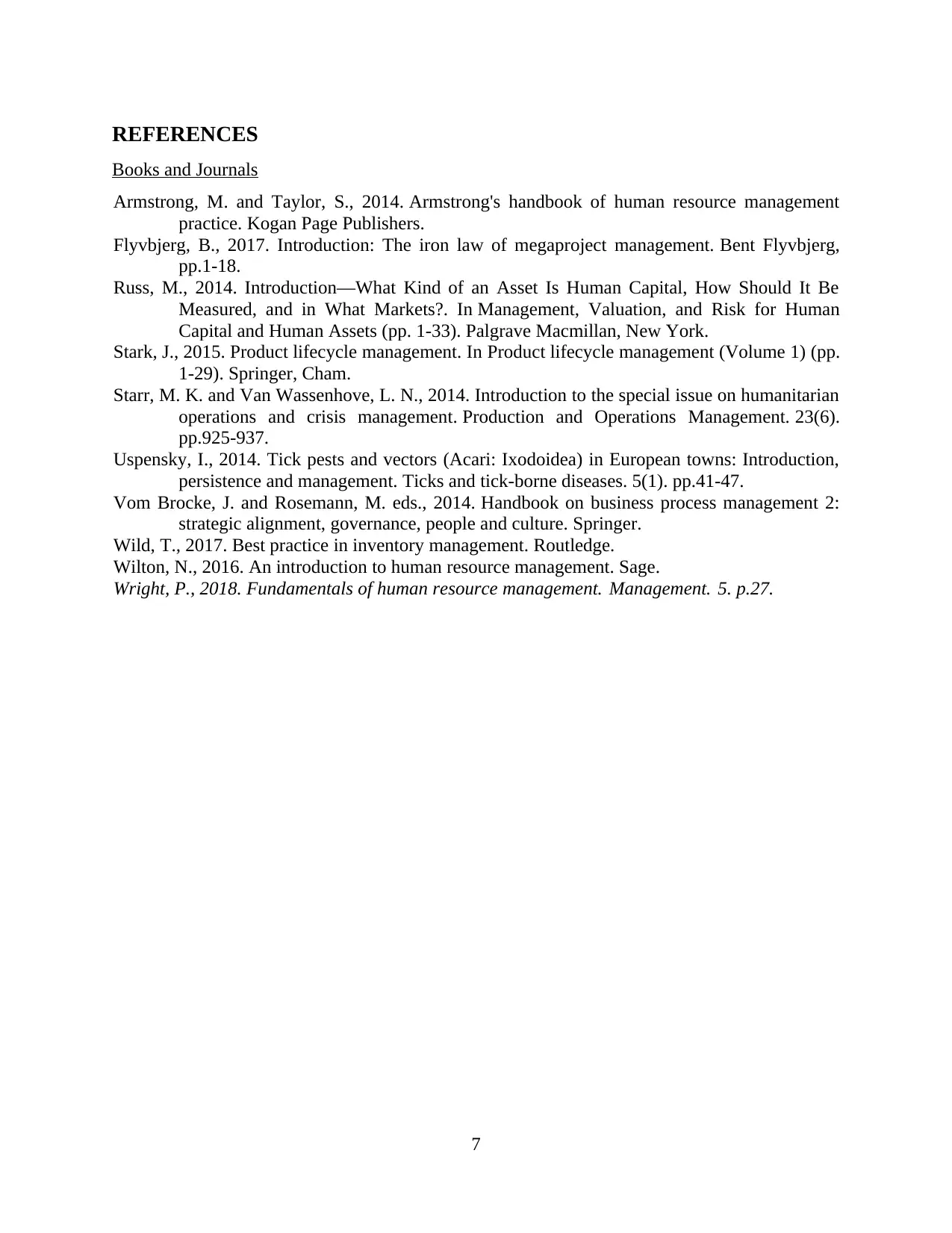
REFERENCES
Books and Journals
Armstrong, M. and Taylor, S., 2014. Armstrong's handbook of human resource management
practice. Kogan Page Publishers.
Flyvbjerg, B., 2017. Introduction: The iron law of megaproject management. Bent Flyvbjerg,
pp.1-18.
Russ, M., 2014. Introduction—What Kind of an Asset Is Human Capital, How Should It Be
Measured, and in What Markets?. In Management, Valuation, and Risk for Human
Capital and Human Assets (pp. 1-33). Palgrave Macmillan, New York.
Stark, J., 2015. Product lifecycle management. In Product lifecycle management (Volume 1) (pp.
1-29). Springer, Cham.
Starr, M. K. and Van Wassenhove, L. N., 2014. Introduction to the special issue on humanitarian
operations and crisis management. Production and Operations Management. 23(6).
pp.925-937.
Uspensky, I., 2014. Tick pests and vectors (Acari: Ixodoidea) in European towns: Introduction,
persistence and management. Ticks and tick-borne diseases. 5(1). pp.41-47.
Vom Brocke, J. and Rosemann, M. eds., 2014. Handbook on business process management 2:
strategic alignment, governance, people and culture. Springer.
Wild, T., 2017. Best practice in inventory management. Routledge.
Wilton, N., 2016. An introduction to human resource management. Sage.
Wright, P., 2018. Fundamentals of human resource management. Management. 5. p.27.
7
Books and Journals
Armstrong, M. and Taylor, S., 2014. Armstrong's handbook of human resource management
practice. Kogan Page Publishers.
Flyvbjerg, B., 2017. Introduction: The iron law of megaproject management. Bent Flyvbjerg,
pp.1-18.
Russ, M., 2014. Introduction—What Kind of an Asset Is Human Capital, How Should It Be
Measured, and in What Markets?. In Management, Valuation, and Risk for Human
Capital and Human Assets (pp. 1-33). Palgrave Macmillan, New York.
Stark, J., 2015. Product lifecycle management. In Product lifecycle management (Volume 1) (pp.
1-29). Springer, Cham.
Starr, M. K. and Van Wassenhove, L. N., 2014. Introduction to the special issue on humanitarian
operations and crisis management. Production and Operations Management. 23(6).
pp.925-937.
Uspensky, I., 2014. Tick pests and vectors (Acari: Ixodoidea) in European towns: Introduction,
persistence and management. Ticks and tick-borne diseases. 5(1). pp.41-47.
Vom Brocke, J. and Rosemann, M. eds., 2014. Handbook on business process management 2:
strategic alignment, governance, people and culture. Springer.
Wild, T., 2017. Best practice in inventory management. Routledge.
Wilton, N., 2016. An introduction to human resource management. Sage.
Wright, P., 2018. Fundamentals of human resource management. Management. 5. p.27.
7

8
Secure Best Marks with AI Grader
Need help grading? Try our AI Grader for instant feedback on your assignments.

9
1 out of 11
Related Documents
Your All-in-One AI-Powered Toolkit for Academic Success.
+13062052269
info@desklib.com
Available 24*7 on WhatsApp / Email
![[object Object]](/_next/static/media/star-bottom.7253800d.svg)
Unlock your academic potential
© 2024 | Zucol Services PVT LTD | All rights reserved.





